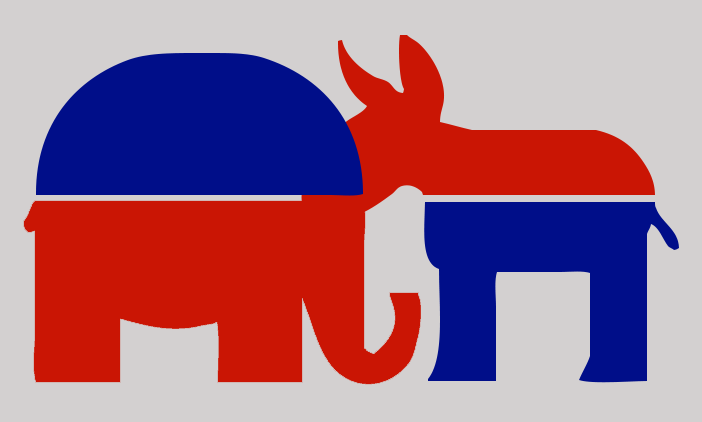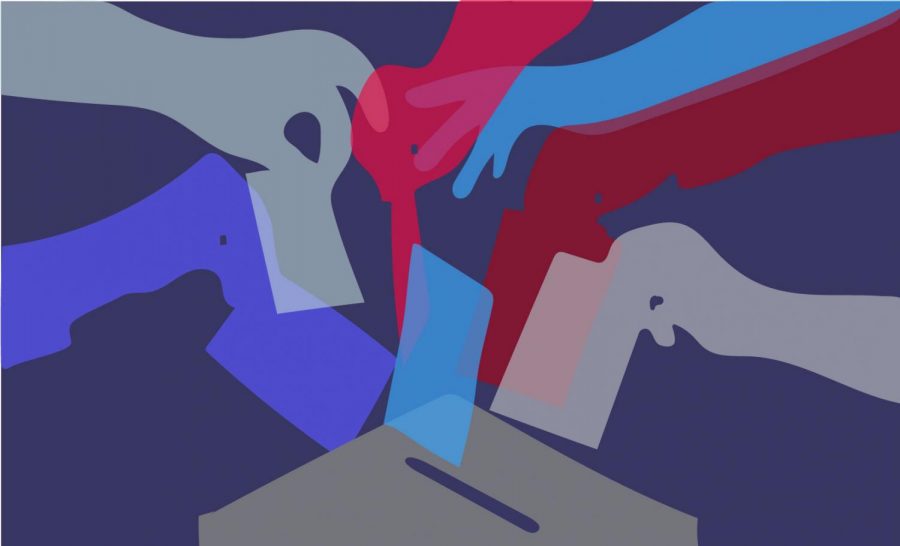The decision to cast a single vote for a particular candidate may seem straightforward, but as Wisconsin voters line up at the polls Nov. 6, many factors come into play concerning political identity.
One of these factors is gender.
A Marquette Law School poll conducted Oct. 3-7 that included 1,000 registered voters in Wisconsin found discrepancies between genders in which candidates they supported.
According to the poll, in both the senatorial and gubernatorial elections, women tended to support the Democratic candidates.
“Women are, on average, more likely to be democrats,” Amber Wichowsky, an associate professor of political science, said. “But women are not a monolithic voting bloc — they are divided by religion, race, education and other factors. For example, (President) Trump won the majority of white women but not Latina or African-American women.”
Janet Boles, professor emerita of political science at Marquette, explained the most significant gap is not the gender gap, but the partisan gap. However, with more women identifying with Democrats for a variety of reasons, the two are connected.
“Public policy drives that party identification,” Boles said. “That is, women like the things that the Democratic Party offers.”
Boles described the Democratic Party as an “activist government” that supports healthcare, education, gun control and abortion without restrictions.
“The Democratic Party gives women what they want,” Boles said. “That isn’t to say they give all women what they want, because certainly there’s a large percentage of women who are Republican. It’s just that more women are Democrats than are Republicans.”
Nationally, the partisan gap is increasing. A recent Quinnipiac University poll found that the gender gap in how men and women say they will vote in the 2018 midterm election is an average of 26 points, which is the largest gap in the history on the poll.
According to Wichowsky, the Wisconsin gender gap is typically larger than the national average.
“This could be because Wisconsin usually has closer statewide elections and voter engagement is higher, so voters are paying attention more,” Wichowsky said.
This trend can be seen in the Marquette Law School polls tracking voter opinions on candidates for governor, United States senator and attorney general.
Gubernatorial focus on education
In the gubernatorial race, Democratic candidate Tony Evers received 32 percent support from white male non-college graduates and 43 percent support from white male college graduates.
However, Evers received more support from female voters. He received 44 percent support from white female non-college graduates and 64 percent support from white female college graduates.
On the other hand, while he notably is the incumbent for this race, Republican candidate Scott Walker, polled more favorably among male voters. He received 60 percent of the vote from white male non-college graduates and 53 percent of the vote from white male college graduates. But among females, he received 46 percent of the vote from white female non-college graduates and only 34 percent of the vote from white female college graduates.
“One distinction between the two candidates is education,” Julia Azari, associate professor and assistant chair of the political science department, said. “Walker is unpopular in the education community overall. Evers has this strong reputation as someone who’s been involved in education for a long time.”
According to Boles, education could be one issue about which women would be particularly concerned.
“Women tend to be pro-education, pro-healthcare and pro-gun control,” Boles said. “I think it goes back to the traditional women’s role as being responsible for the family and for children, and those are essentially family and children’s issues.”
Senate race unique with two female candidates
The race for U.S. Senate is unique in that both candidates are female.
Democratic incumbent Tammy Baldwin still enjoys more support from female voters than Republican candidate Leah Vukmir.
According to the Marquette University Law School poll, Baldwin is supported by 56 percent of white female non-college graduates and 66 percent of white female college graduates. But she is only supported by 38 percent of white male non-college graduates and 50 percent of white male college graduates.
Vukmir does not garner the same female support in poll results.
Vukmir received support from only 39 percent of white female non-college graduates and only 29 percent of white female college-graduates. However, she is more favorable among male voters, receiving support from 58 percent of white male non-college graduates and 50 percent of white male college graduates.
“The important thing to emphasize about gender in a race with two women, or two men for that matter, is that gender is not just fixed,” Azari said. “It’s a way that the candidates emphasize certain traits and imagery and self-presentation that can have a big range and a lot of nuances.”
Azari explained that this can be seen in the way the two candidates promote their respective images.
“It’s interesting if you look at some of Vukmir’s ads,” Azari said. “In the primaries when she was running against Kevin Nicholson, she had this ad where she had herself with a gun talking about protecting herself… she presents an image that draws a lot of stereotypically masculine traits.”
But Azari said that Vukmir’s ads have changed depending on the demographic she is trying to attract.
“In the general, she has these ads where she emphasizes her background in nursing,” Azari said. “She’s pictured with kids, and she’s really emphasizing a more feminine image.”
Baldwin’s advertising takes a different approach, Azari said.
“Tammy Baldwin has an interesting gender presentation,” Azari said. “She kind of projects a very stereotypically feminine physical appearance, she’s a lesbian and so I think over the years in her career in Congress she’s deliberately cultivated that image to push back against homophobia.”
Attorney general race localized
The attorney general race, a more localized election, still shows slight gender discrepancies according to the Marquette University Law School poll.
The poll found the Republican incumbent Brad Schimel is supported by 61 percent of white male non-college graduates and 54 percent of white male college graduates. In terms of female support, Schimel received support from 43 percent of white female non-college graduates and 39 percent of white female college graduates.
His Democratic opponent Josh Kaul is supported by 32 percent of white male non-college graduates and 38 percent of white male college graduates. He gets more support from female voters, with support from 44 percent of white female non-college graduates and 39 percent of white female college graduates.
“That election is not as nationalized, so it has not been tied to some of these national, more symbolic and ideological conversations,” Azari said. “I think in general, local elections have become more nationalized, but some elections have been a little immune from that.”
Voters of color and historical trends
The most recent Marquette Law School poll only divided the white participants by gender when examining gender preferences in these three races.
“Because there are subgroups polled, it was divided into smaller groups of people, which makes it harder to untangle and interrogate different groups,” Wichowsky said. “Many other polls use oversampling to differentiate race, gender or education level. This means they may increase the African American or Latino voters polled.”
According to Wichowsky, the gender gap has historical precedence and both genders have contributed to it, not just females. However, she said there have been significant shifts in gender and party alignment over the years.
“In the 1950s, women were more Republican and more religious,” Wichowsky said. “Then white men began changing parties in the 1980s due to changing platforms in the Republican Party on racial and gender equality. Many white voters did not like the New Deal and preferred the Republican’s more limited form of government.”
Wichowsky also said that women entering the workplace and the Republican Party’s change from pro-choice to pro-life also contributed to this realignment.
Boles said she believes that the political preferences of each gender can be advantageous or disadvantageous to candidates.
“It’s a matter of who turns out to vote,” Boles said. “Since 1964, a total of more female votes have been cast than have been cast by men. And since 1980, that of course continues to be true because there are more women than men in the electorate, but women are now equally or usually more likely to turn out to vote.”
When being a woman can be advantageous
Boles said that since there are more votes from women than from men, the “women’s candidate” may be advantaged.
Boles explained that national trends often influence the way that gender plays a role in local elections, and both parties view the issue differently.
“I think that the Republican Party has said basically said, ‘Well, the gender gap shows that we Republicans are doing really well with men,’” Boles said. “So I think that both parties are not particularly concerned about reaching women per se.”
Azari said she believes that political parties addressing gender in politics can be tricky, and both parties are trying to use it to their advantage.
She said that gender is often addressed badly, such as in the 2016 presidential election. Azari said she believes that the democrats “overshot” by focusing too much on gender in Hillary Clinton’s campaign.
Azari said that the Republicans have also addressed gender in their political campaigns.
“Their messaging around (the) #MeToo (movement) has been pretty effective and they’ve managed to get a lot of public support for the idea that this has gone too far and there’s false accusations and everyone’s vulnerable,” Azari said. “And that message has resonated with people who identify with the GOP.”
Men shape gender politics as much as women
But Wichowsky said that gender politics are not just about the female vote.
“In discussing gender, we cannot forget men,” Wichowsky said. “Democratic men and men with college degrees are more likely to vote Democratic.”
Azari agrees that men have shaped gender politics as much as women. She said that there has been a trend in the past decades of white men turning away from the Democratic Party and toward the Republican Party’s images of masculinity that appeal to them.
While gender itself is not the only political identity people hold, Azari said she believes it can still make a difference in the upcoming midterm Wisconsin elections.
“We have fairly competitive elections in this state,” Azari said. “So any factor, even if it moves around a few thousand voters there or there, is going to be pretty important.”






